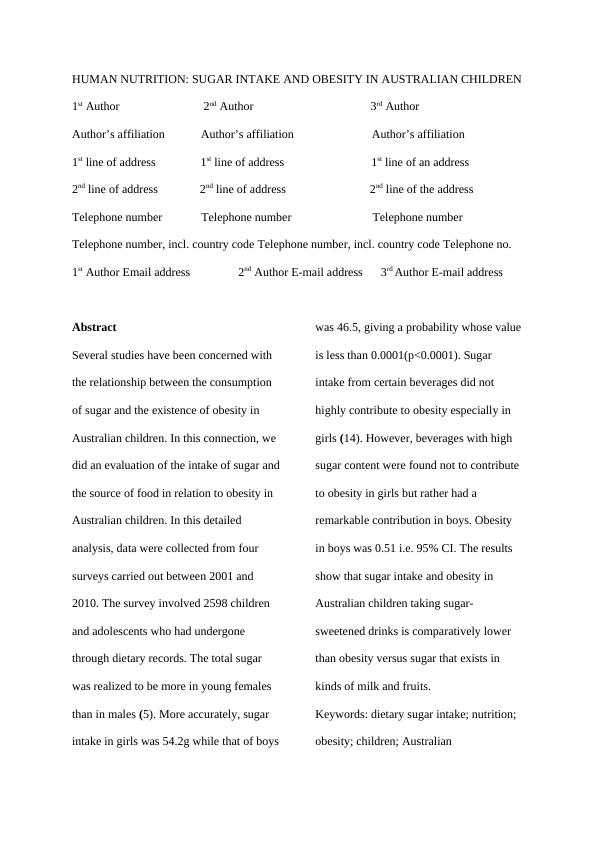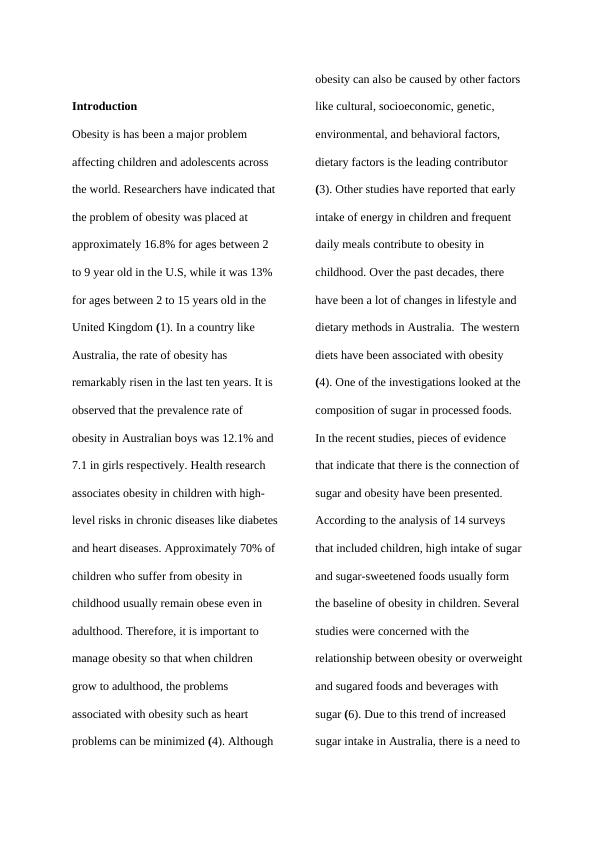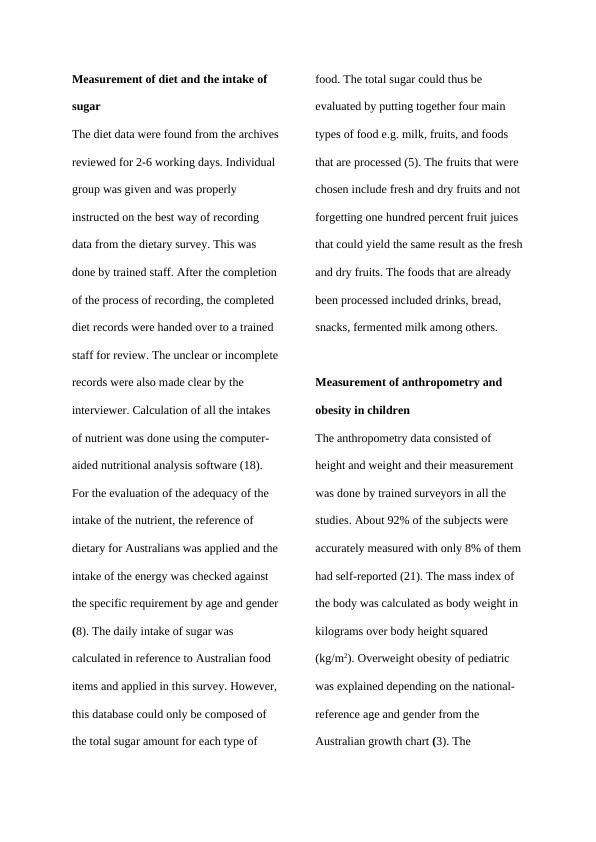Sugar Intake and Obesity in Australian Children: A Detailed Analysis
This assignment requires a research proposal and literature review on the topic of sugar intake in Australian children, for the course HSN735 Research Practice in Human Nutrition.
16 Pages4922 Words433 Views
Added on 2023-05-31
About This Document
This article evaluates the intake of sugar and the source of food in relation to obesity in Australian children. The survey involved 2598 children and adolescents who had undergone through dietary records. The article provides a detailed analysis of the relationship between sugar intake and obesity in Australian children.
Sugar Intake and Obesity in Australian Children: A Detailed Analysis
This assignment requires a research proposal and literature review on the topic of sugar intake in Australian children, for the course HSN735 Research Practice in Human Nutrition.
Added on 2023-05-31
ShareRelated Documents
HUMAN NUTRITION: SUGAR INTAKE AND OBESITY IN AUSTRALIAN CHILDREN
1st Author 2nd Author 3rd Author
Author’s affiliation Author’s affiliation Author’s affiliation
1st line of address 1st line of address 1st line of an address
2nd line of address 2nd line of address 2nd line of the address
Telephone number Telephone number Telephone number
Telephone number, incl. country code Telephone number, incl. country code Telephone no.
1st Author Email address 2nd Author E-mail address 3rd Author E-mail address
Abstract
Several studies have been concerned with
the relationship between the consumption
of sugar and the existence of obesity in
Australian children. In this connection, we
did an evaluation of the intake of sugar and
the source of food in relation to obesity in
Australian children. In this detailed
analysis, data were collected from four
surveys carried out between 2001 and
2010. The survey involved 2598 children
and adolescents who had undergone
through dietary records. The total sugar
was realized to be more in young females
than in males (5). More accurately, sugar
intake in girls was 54.2g while that of boys
was 46.5, giving a probability whose value
is less than 0.0001(p<0.0001). Sugar
intake from certain beverages did not
highly contribute to obesity especially in
girls (14). However, beverages with high
sugar content were found not to contribute
to obesity in girls but rather had a
remarkable contribution in boys. Obesity
in boys was 0.51 i.e. 95% CI. The results
show that sugar intake and obesity in
Australian children taking sugar-
sweetened drinks is comparatively lower
than obesity versus sugar that exists in
kinds of milk and fruits.
Keywords: dietary sugar intake; nutrition;
obesity; children; Australian
1st Author 2nd Author 3rd Author
Author’s affiliation Author’s affiliation Author’s affiliation
1st line of address 1st line of address 1st line of an address
2nd line of address 2nd line of address 2nd line of the address
Telephone number Telephone number Telephone number
Telephone number, incl. country code Telephone number, incl. country code Telephone no.
1st Author Email address 2nd Author E-mail address 3rd Author E-mail address
Abstract
Several studies have been concerned with
the relationship between the consumption
of sugar and the existence of obesity in
Australian children. In this connection, we
did an evaluation of the intake of sugar and
the source of food in relation to obesity in
Australian children. In this detailed
analysis, data were collected from four
surveys carried out between 2001 and
2010. The survey involved 2598 children
and adolescents who had undergone
through dietary records. The total sugar
was realized to be more in young females
than in males (5). More accurately, sugar
intake in girls was 54.2g while that of boys
was 46.5, giving a probability whose value
is less than 0.0001(p<0.0001). Sugar
intake from certain beverages did not
highly contribute to obesity especially in
girls (14). However, beverages with high
sugar content were found not to contribute
to obesity in girls but rather had a
remarkable contribution in boys. Obesity
in boys was 0.51 i.e. 95% CI. The results
show that sugar intake and obesity in
Australian children taking sugar-
sweetened drinks is comparatively lower
than obesity versus sugar that exists in
kinds of milk and fruits.
Keywords: dietary sugar intake; nutrition;
obesity; children; Australian

Introduction
Obesity is has been a major problem
affecting children and adolescents across
the world. Researchers have indicated that
the problem of obesity was placed at
approximately 16.8% for ages between 2
to 9 year old in the U.S, while it was 13%
for ages between 2 to 15 years old in the
United Kingdom (1). In a country like
Australia, the rate of obesity has
remarkably risen in the last ten years. It is
observed that the prevalence rate of
obesity in Australian boys was 12.1% and
7.1 in girls respectively. Health research
associates obesity in children with high-
level risks in chronic diseases like diabetes
and heart diseases. Approximately 70% of
children who suffer from obesity in
childhood usually remain obese even in
adulthood. Therefore, it is important to
manage obesity so that when children
grow to adulthood, the problems
associated with obesity such as heart
problems can be minimized (4). Although
obesity can also be caused by other factors
like cultural, socioeconomic, genetic,
environmental, and behavioral factors,
dietary factors is the leading contributor
(3). Other studies have reported that early
intake of energy in children and frequent
daily meals contribute to obesity in
childhood. Over the past decades, there
have been a lot of changes in lifestyle and
dietary methods in Australia. The western
diets have been associated with obesity
(4). One of the investigations looked at the
composition of sugar in processed foods.
In the recent studies, pieces of evidence
that indicate that there is the connection of
sugar and obesity have been presented.
According to the analysis of 14 surveys
that included children, high intake of sugar
and sugar-sweetened foods usually form
the baseline of obesity in children. Several
studies were concerned with the
relationship between obesity or overweight
and sugared foods and beverages with
sugar (6). Due to this trend of increased
sugar intake in Australia, there is a need to
Obesity is has been a major problem
affecting children and adolescents across
the world. Researchers have indicated that
the problem of obesity was placed at
approximately 16.8% for ages between 2
to 9 year old in the U.S, while it was 13%
for ages between 2 to 15 years old in the
United Kingdom (1). In a country like
Australia, the rate of obesity has
remarkably risen in the last ten years. It is
observed that the prevalence rate of
obesity in Australian boys was 12.1% and
7.1 in girls respectively. Health research
associates obesity in children with high-
level risks in chronic diseases like diabetes
and heart diseases. Approximately 70% of
children who suffer from obesity in
childhood usually remain obese even in
adulthood. Therefore, it is important to
manage obesity so that when children
grow to adulthood, the problems
associated with obesity such as heart
problems can be minimized (4). Although
obesity can also be caused by other factors
like cultural, socioeconomic, genetic,
environmental, and behavioral factors,
dietary factors is the leading contributor
(3). Other studies have reported that early
intake of energy in children and frequent
daily meals contribute to obesity in
childhood. Over the past decades, there
have been a lot of changes in lifestyle and
dietary methods in Australia. The western
diets have been associated with obesity
(4). One of the investigations looked at the
composition of sugar in processed foods.
In the recent studies, pieces of evidence
that indicate that there is the connection of
sugar and obesity have been presented.
According to the analysis of 14 surveys
that included children, high intake of sugar
and sugar-sweetened foods usually form
the baseline of obesity in children. Several
studies were concerned with the
relationship between obesity or overweight
and sugared foods and beverages with
sugar (6). Due to this trend of increased
sugar intake in Australia, there is a need to

investigate the effects caused by this
increase; explain the consequences, and
recommend the steps to be taken to curb
the problem (17). More specifically, the
amount of sugar intake by Australian
children in the last decade is approximated
to have risen from 66.4g to 69.5g in six to
eleven years and 76.4g to 79.0g in twelve
to eighteen year old.
Methods
Data collection and population study
The data were derived from 5 surveys
carried out on Australian children between
2001 and 2010. All the criteria for the
analysis of secondary data were included
and the study looked at quantitative data
for diets, which included at least three days
of analyzing the data for the children's
diet. A total of five studies employed
similar procedures for the assessment of
dietary sugar intake in children. However,
some outcome variables, for example, the
mineral density of the bone and the food
allergy had no similarities (9). Some
detailed information about the five studies
has been shown in Appendix Table A1.
The original study looked at 4952 children
and for a good comparison, this number
included adolescents. The ages of the
respondents were between 8-13 years.
These children were from 7 elementary
school, 2 middle-level learning centers,
and a care center. The criteria used was
that if any survey completed 3 or more
days of the diets’ records and other
parameters such as age and gender with no
disease (n=4087). Out of the 4087
subjects, we exempted the ones without
accurate information or those with
incomplete information on anthropometric
measurement e.g. length and mass (n=94)
and incomplete data for material education
(n= 1254). The last sample contained 2598
children and adolescents (1047 males and
1551 females) 8-13 years old. The survey
was endorsed by the Institutional Review
Board.
increase; explain the consequences, and
recommend the steps to be taken to curb
the problem (17). More specifically, the
amount of sugar intake by Australian
children in the last decade is approximated
to have risen from 66.4g to 69.5g in six to
eleven years and 76.4g to 79.0g in twelve
to eighteen year old.
Methods
Data collection and population study
The data were derived from 5 surveys
carried out on Australian children between
2001 and 2010. All the criteria for the
analysis of secondary data were included
and the study looked at quantitative data
for diets, which included at least three days
of analyzing the data for the children's
diet. A total of five studies employed
similar procedures for the assessment of
dietary sugar intake in children. However,
some outcome variables, for example, the
mineral density of the bone and the food
allergy had no similarities (9). Some
detailed information about the five studies
has been shown in Appendix Table A1.
The original study looked at 4952 children
and for a good comparison, this number
included adolescents. The ages of the
respondents were between 8-13 years.
These children were from 7 elementary
school, 2 middle-level learning centers,
and a care center. The criteria used was
that if any survey completed 3 or more
days of the diets’ records and other
parameters such as age and gender with no
disease (n=4087). Out of the 4087
subjects, we exempted the ones without
accurate information or those with
incomplete information on anthropometric
measurement e.g. length and mass (n=94)
and incomplete data for material education
(n= 1254). The last sample contained 2598
children and adolescents (1047 males and
1551 females) 8-13 years old. The survey
was endorsed by the Institutional Review
Board.

Measurement of diet and the intake of
sugar
The diet data were found from the archives
reviewed for 2-6 working days. Individual
group was given and was properly
instructed on the best way of recording
data from the dietary survey. This was
done by trained staff. After the completion
of the process of recording, the completed
diet records were handed over to a trained
staff for review. The unclear or incomplete
records were also made clear by the
interviewer. Calculation of all the intakes
of nutrient was done using the computer-
aided nutritional analysis software (18).
For the evaluation of the adequacy of the
intake of the nutrient, the reference of
dietary for Australians was applied and the
intake of the energy was checked against
the specific requirement by age and gender
(8). The daily intake of sugar was
calculated in reference to Australian food
items and applied in this survey. However,
this database could only be composed of
the total sugar amount for each type of
food. The total sugar could thus be
evaluated by putting together four main
types of food e.g. milk, fruits, and foods
that are processed (5). The fruits that were
chosen include fresh and dry fruits and not
forgetting one hundred percent fruit juices
that could yield the same result as the fresh
and dry fruits. The foods that are already
been processed included drinks, bread,
snacks, fermented milk among others.
Measurement of anthropometry and
obesity in children
The anthropometry data consisted of
height and weight and their measurement
was done by trained surveyors in all the
studies. About 92% of the subjects were
accurately measured with only 8% of them
had self-reported (21). The mass index of
the body was calculated as body weight in
kilograms over body height squared
(kg/m2). Overweight obesity of pediatric
was explained depending on the national-
reference age and gender from the
Australian growth chart (3). The
sugar
The diet data were found from the archives
reviewed for 2-6 working days. Individual
group was given and was properly
instructed on the best way of recording
data from the dietary survey. This was
done by trained staff. After the completion
of the process of recording, the completed
diet records were handed over to a trained
staff for review. The unclear or incomplete
records were also made clear by the
interviewer. Calculation of all the intakes
of nutrient was done using the computer-
aided nutritional analysis software (18).
For the evaluation of the adequacy of the
intake of the nutrient, the reference of
dietary for Australians was applied and the
intake of the energy was checked against
the specific requirement by age and gender
(8). The daily intake of sugar was
calculated in reference to Australian food
items and applied in this survey. However,
this database could only be composed of
the total sugar amount for each type of
food. The total sugar could thus be
evaluated by putting together four main
types of food e.g. milk, fruits, and foods
that are processed (5). The fruits that were
chosen include fresh and dry fruits and not
forgetting one hundred percent fruit juices
that could yield the same result as the fresh
and dry fruits. The foods that are already
been processed included drinks, bread,
snacks, fermented milk among others.
Measurement of anthropometry and
obesity in children
The anthropometry data consisted of
height and weight and their measurement
was done by trained surveyors in all the
studies. About 92% of the subjects were
accurately measured with only 8% of them
had self-reported (21). The mass index of
the body was calculated as body weight in
kilograms over body height squared
(kg/m2). Overweight obesity of pediatric
was explained depending on the national-
reference age and gender from the
Australian growth chart (3). The

End of preview
Want to access all the pages? Upload your documents or become a member.
Related Documents
Self Driven Vehicles versus Manual Driving Vehicleslg...
|12
|2990
|335
